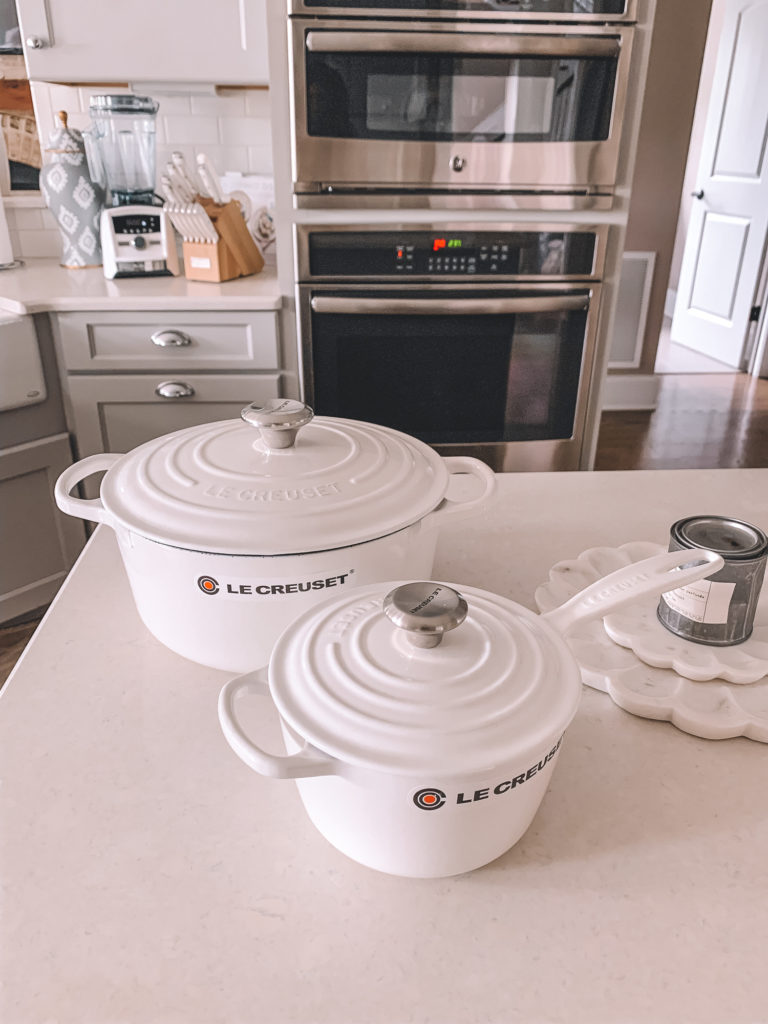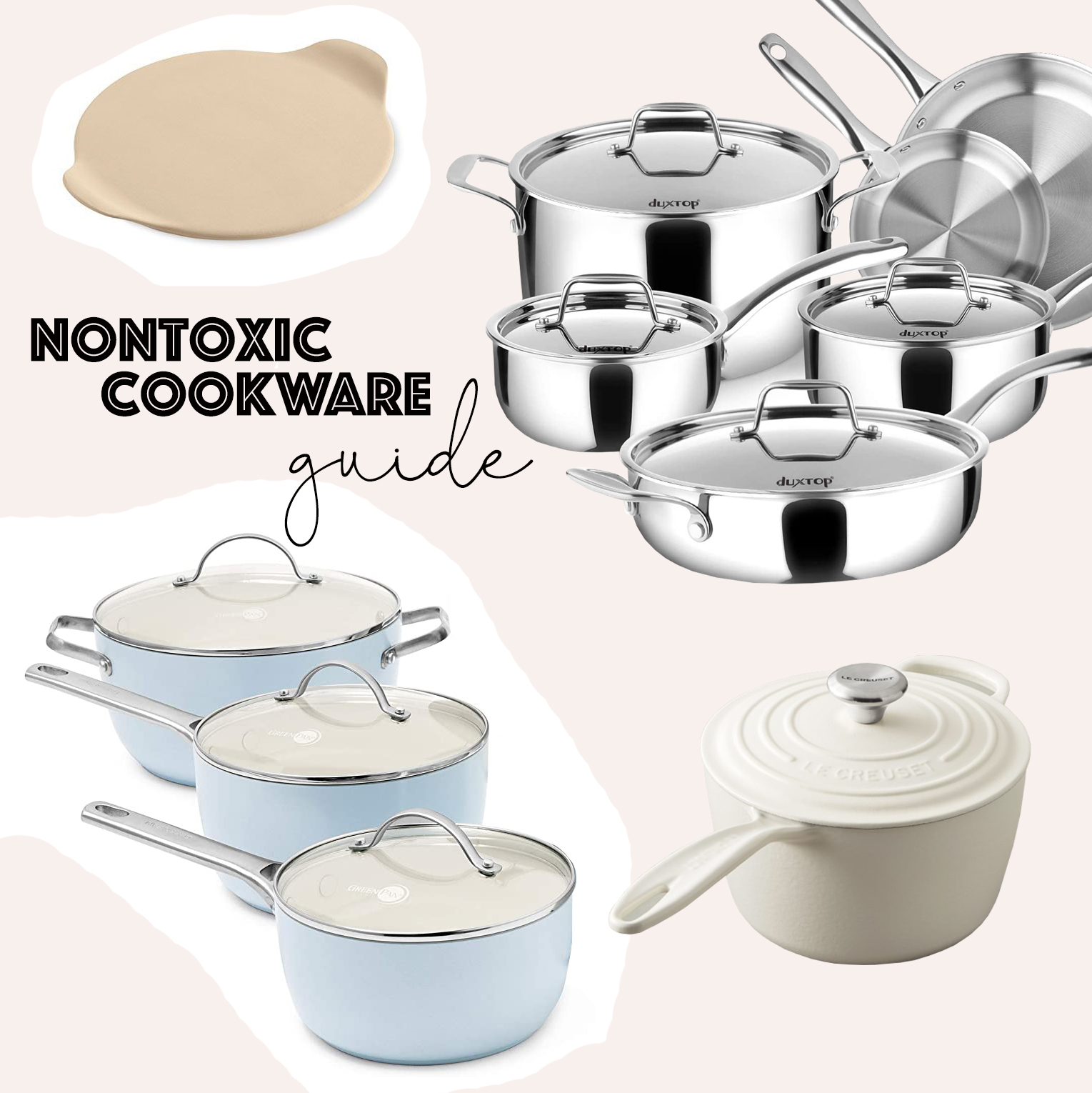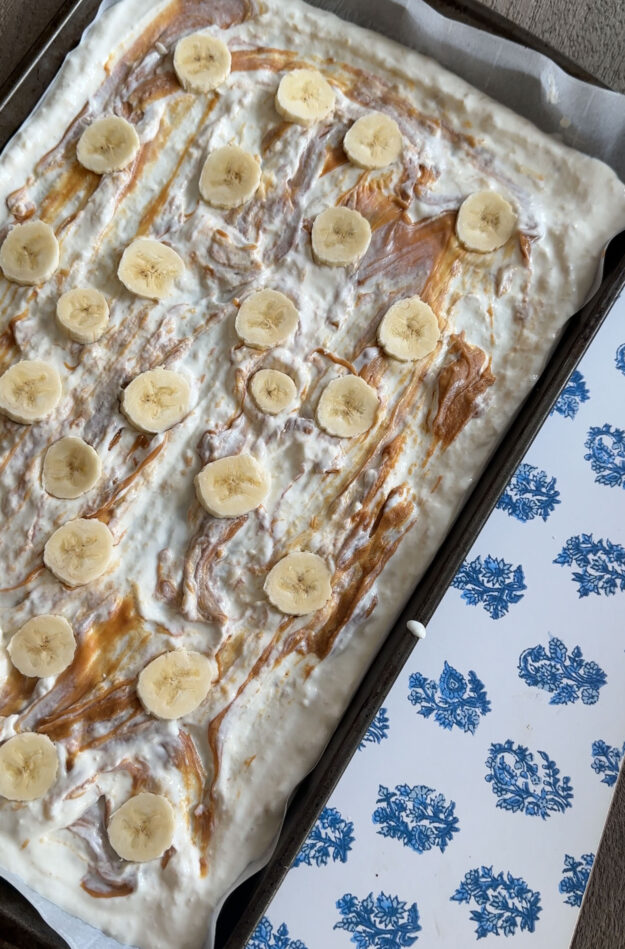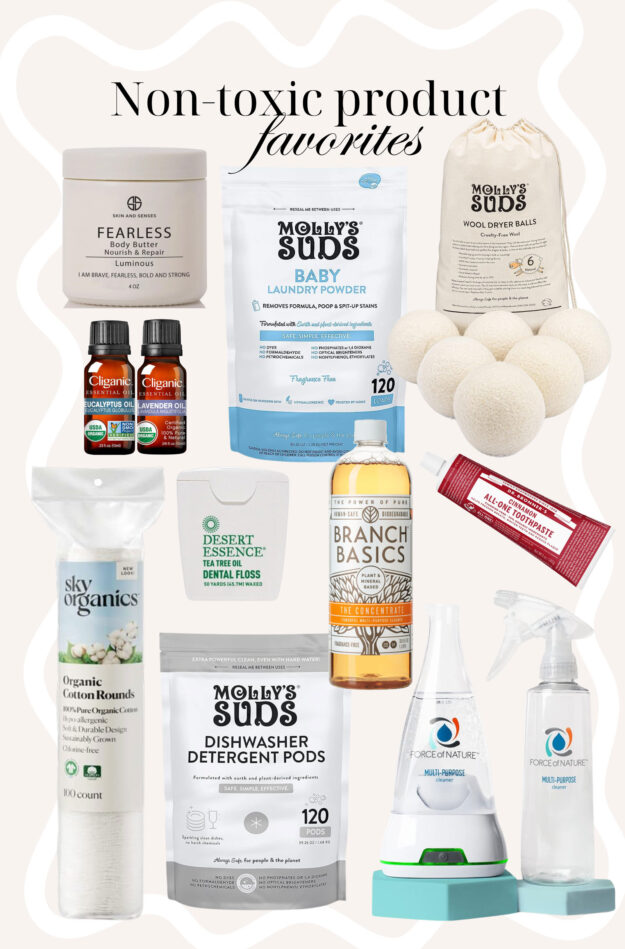I remember when I graduated college and landed my first “big girl job,” the very first thing I did was go out and buy an expensive set of Teflon nonstick cookware from Williams Sonoma. I was so proud of that cookware, and felt like such an adult cooking with them in my first apartment. Those pots and pans lasted me a long time… through my move to Charlotte, an apartment in Winston Salem, and even into my marriage to Chris and the move to our house. Little did I know, those pots and pans that I was so proud of, could have been slowly making us sick. Although nonstick may *seem* like the greatest invention ever, the chemicals have been linked to infertility and known to contribute to testicular and kidney cancer, liver damage, thyroid disease and ulcerative colitis (source). If you don’t believe me, google it for yourself! The negative health effects are not just speculated, they’ve been proven. It makes me sick to think about all of the years I cooked with those pots and pans!
So what’s in Nonstick Pans that’s so bad for us?
The two chemicals to look out for in your pots and pans are polytetrafluoroethylene (PTFE) and perfluorooctanoic acid (PFOA). The main concern with PTFE is that it starts to break down and release toxic fumes when it’s heated to high temperatures. As for PFOA, this chemical is in the coating of a lot of non-stick cookware, and leaches into our food while we cook. It has been linked to a number of health conditions and is now present in most people’s blood (source). Although several non-stick cookware brands currently claim to be PFOA-free, they may have been made with other fluoropolymers with similar properties, and therefore, have similar concerns as PFOA.
Even though a lot of cookware brands claim to be “non-toxic” and PFOA-free, you really have to do your research! There are tons of different chemicals out there, and the truth is that most types of cookware do infuse small amounts of material into our food. Some of those things are bad for us, some are good in the right quantity, and some are neutral. I don’t think I need to tell you this, but… as much as we should avoid toxins in what we breathe and touch, we REALLY should avoid eating them!
What to Use Instead
Cast Iron
Humans have been cooking with cast iron for thousands of years. Unlike Teflon and other non-stick pans, cast iron is not made with any chemicals at all – it’s made from a single piece of metal and then seasoned (through a process of oiling and heating) to protect the bare cast iron and give it a low-stick coating. Some of the pros are that they have a long life span and are basically indestructible. They’re also dual purpose because you can use them on the stove as well as in the oven, at any temperature. Cast iron is a great choice if you wish to avoid chemically-treated cookware, but know that it does leach a small amount of iron into your food. This can be great for a lot of people who don’t get enough iron from their diets or if you suffer from iron deficiency.
Porcelain Enamel
In essence, enamel is a form of glass, and enameled cookware is most often cast iron with an enamel coating (think Le Creuset). In my opinion, this type of cookware is completely non-toxic and wonderful to cook with. Cast iron construction conducts and holds heat well, providing an even consistent temperature throughout the entire pot, and the enamel glazed surface does not need any kind of seasoning, so it requires little maintenance. It is important to check with the manufacturer for the presence of heavy metals like lead and cadmium in enamel glazes before purchasing an item. I cannot vouch for other brands of porcelain enamel cookware, but I feel good about Le Creuset! They have done extensive testing on all of their products. One caveat: Le Creuset says that there are trace amounts of lead on the outside of the bright-colored Le Creuset pots (such as red and orange). They add that “these levels are very low, but the interior enamel is completely free of lead.” To be safe, I stick with the white Le Creuset pots and pans (which I think are the prettiest, anyways!).
Tempered Glass
Glass is probably the most inert of any cooking surface. It’s eco-friendly, nontoxic and durable – a great material to choose when stocking your kitchen with chemical-free cookware. I didn’t know this, but you can even get pots and pans made of it. This set has amazing reviews on Amazon.
Stoneware
More for baking rather than cooking on the stove, stoneware is a great alternative to traditional aluminum baking sheets. Stoneware is non-reactive and won’t leach chemicals into your food, and is able to withstand even the hottest oven temperature possible. The only disadvantage is that they can be tricky to clean since you can’t use soap on them (since the stone absorbs the flavor), but water and a food scraper will do the trick nicely.
Be Cautious Of…
Aluminum
Aluminum cookware has been popular for years as it’s lightweight, easy to use, and relatively easy to clean. The only issue with aluminum cookware is that it does leach aluminum into your food. Aluminum exists naturally in the environment, but is toxic at certain amounts, and scientists can’t agree on what that amount is. This article details more, but some studies suggest that aluminum exposure may be linked to neurotoxicity (adverse health effects on the central or peripheral nervous system or both), Alzheimer’s disease, and breast cancer.
Unprotected Copper
Copper’s main advantage is its high thermal conductivity, enabling the cooking surface to heat quickly and evenly as well as respond quickly to changes in cooking temperature. However, copper and nickel, both toxic heavy metals, are found in the finish of copper cookware and can be leached into food.
Non-Stick (Teflon)
I am skeptical of any pan with a non-stick coating. This is a little tricky to explain, so stick with me! Non-stick cookware is typically coated with a material called polytetrafluoroethylene (PTFE), commonly known as Teflon (which I talked about at the beginning of this blog post!). It was first made in the 1930s and is so unreactive, food molecules can’t bond with it and slide right off. Most of the health concerns have centered on a chemical called perfluorooctanoic acid (PFOA), which has been linked to a number of health conditions, including thyroid disorders, chronic kidney disease, liver disease and testicular cancer, infertility and low birth weight (take a look at the studies here, here, here, and here for more info). If you have Teflon pans from 2013 or prior, it’s time to replace them. But when buying new ones, beware: just because a pan says ‘No PFOA’ or ‘No PTFE’ doesn’t mean it doesn’t contain perfluorinated substances. A lot of the chemicals used to make nonstick pans are structurally similar and will be persistent in the environment and our bodies, with similar health effects (source).
Stainless Steel
Stainless steel is easy to clean and maintain, and will last a long time if properly taken care of. But similar to aluminum and copper cookware, stainless steel cookware poses a risk of leaching (source). While stainless steel isn’t treated with a chemical coating, it is comprised of an alloy containing nickel and chromium. Compared to chromium, nickel leaching is a much more serious issue since it’s right up there in the Substance Priority List (SPL) of the Agency for Toxic Substances and Disease Registry (ATSDR). We only need trace amounts of nickel in our body, and we already get enough from foods like nuts, chocolate, and grains.

What I Use
As you can tell, there is not one piece of cookware that is absolutely perfect, but based on the research I’ve done, I do feel confident in the cookware I use! If you follow me on Instagram, you probably already know that I loveeee my Le Creuset pieces. I own this saucepan (which is great for heating up soups and sauces), this Dutch Oven and this fry pan. I also just got in this set of GreenPan cookware that is made with Thermalon, a sand derivative containing silicon dioxide instead of Teflon. GreenPan discloses their test scores for a wide range of chemicals, and their scores look really great. Just to be extra safe, I only use wooden or plastic utensils with them (never metal) and don’t heat them to extremely high temperatures. The fry pan is what I reach for most often – it is incredible for scrambling eggs and making pancakes and is truly nonstick. I don’t feel that I’ve owned the GreenPan cookware long enough to give an accurate review, though, so I will update you guys after I’ve cooked with them for a longer amount of time!
When it comes to baking, I use a lot of stoneware. I own this stoneware cookie sheet and this pizza stone and love both. Stoneware is completely nontoxic but you can’t use soap to wash it – the nonstick “seasoning” actually builds up with every use and gets better the more you use it. When it comes to chicken bakes, casseroles and cakes, I love my handy Le Creuset stoneware – I have both this one and this one.
I linked up all of my personal pots and pans in the widget below! Also, I really encourage you all to do your own research when it comes to non-toxic pots and pans. I am not an expert, but just wanted to share what I have learned so far!




Thank you! I’ve been considering the same thing for my family w our pans and cookware. I wish I would have done this when our kids were babies. I’m going to start the transition, it adds up quickly! I appreciate your insight and information. Thank you.
Great information and sources! Thank you for the time you have put into this and for sharing! Did you happen to look into Le Creuset toughened non-stick line? We use the frying pans from that line. They say they are free of harmful chemicals, but I now know it can’t be trusted. I’m curious since you use a different brand for frying pans
Caitlin, thank you so much for this post. my mom is currently in the ICU and they can’t figure out why (thankfully we know it’s not COVID) but my dad and I think it’s because we use teflon nonstick pans. we’re placing an order today for a set of the green pan because after your research (and what we’ve started doing on our own) we think it’s best for our family to move forward with things that have no chemicals. i don’t think i would’ve know about green pan if not for you so THANK YOU.
I hope your mom feels better soon!!!! <3
This is such great info!! We recently replaced our pots and pans with “green pans”… a little pricey, but definitely worth it! I love the look of the blue pans you’ve listed! They are So Pretty!! 💙
I love this post! Another good tip is to use unbleached parchment paper (whole foods sells their own and so does the If You Care brand) whenever using parchment as bleached white parchment paper can also leach bleach into your food. Thank you for being so creative with all of your content during this unusual time. Your blog is the best!
Thank you for sharing! This is super helpful and not something I would have though of!
I love learning about topics like these, I found this blogpost to be really educational.
Thanks for sharing, Caitlin!
xx Janine
https://walkinmysneaks.blogspot.com
This post came at such a perfect time. I recently learned about Green Pan cookware last year, and just two nights ago, I was reading about their products and doing research. I am also considering of getting Le Creuset cookware. Because they are expensive, have you thought about doing a giveaway? 😉 Thank you for this detailed post.
That’s a great idea for a giveaway!!
Thank you for sharing ! 💖 To be frank, I learned a lot from you about healthy lifestyle. And I was waiting for this post since you post them on your stories. Online shopping is not a thing where I live, but after this pandemic ends; I’m planning to invest in healthy cookware 🌱
Great post! I use cast iron and stoneware and love them!
I love the GreenPan set, however they really got bad reviews on Amazon. I’m anxious to see what you think after some use.
Thank you for this post! Have your Green Pans and white Le Creuset dishes stayed white or do they stain easily?
The Le Creuset have stayed pristine white! I haven’t cooked on the GreenPan long enough to see a color change yet but I will update everyone in a few months!
Now that you have had the GreenPan longer, would you still recommend them? Do they still have their nonstick function? I’ve had issues with other ceramic pans loosing their non-stick after a month or so.
If you buy medical-grade stainless steel cookware – then it can actually be one of the safest forms of pots and pans. I love my 360 cookware pans.
Thank you for passing along the information!
Hello! Do you have a recommendation for a safe cupcake pan? Thanks for this post, appreciate all the time and research you’ve put into it! Best
Thank you SO MUCH for sharing this! So informative. Will definitely be making the switch as well!
xo Laura Leigh
https://louellareese.com
Definitely looking into the stoneware cookie sheet! I switched from Teflon/nonstick nearly a decade ago and love that there are so many more – safer – options now coming onto the market! Thanks for this post, and link to cookie sheet!
xo, Mia | https://miaatthemoment.com/
Thanks for this post, it was really useful! Just wanted to add, for anyone who does have a pan with leaching concerns (like aluminum and stainless steel) but wants to continue using it: I would avoid cooking acidic foods (tomatoes are a big offender) and especially avoid storing acidic foods in these pans, as the acid will cause even more leaching, sometimes to the point where you can taste the metal.
Glad you mentioned GreenPan, they look like a more affordable option to Le Creuset.
Thanks for the options and post!
Can you repost the tempered glass Amazon link? I keep getting an error message. Thanks again!
Sorry about that – just fixed the link!
I was excited to see your post on cookware because I have been trying to find a new set myself that isn’t Teflon coated however when I clicked on your Greenpan links and the 2 LeCreuset baking pan links you provided, the reviews are horrible from people. You haven’t had any cracks and/or breaks in your baking pans?
I haven’t used the GreenPan pots and pans long enough to tell, but so far they have been wonderful. As for Le Creuset, I find it hard to believe they have bad reviews!! I have used those baking pans for several years now and they cook so evenly and are in MINT condition (still look the same as when I bought them!). I stand by them 100%!
This was SO helpful! You really helped me understand all of the important items to consider. This got me to do a lot of research on my own too. I found that Caraway seems to have it all – is there a reason you didn’t mention their cookware sets? Looks amazing but I’m not sure since you didn’t mention it so I wanted to ask. Thanks!
Hey Caitlin,
Do you have any recommendations for cooking utensils that are free of chemicals? I am redoing my wedding registry now that I have read your articles! Thank you!
Following this! I’m redoing my registry too and on the hunt for healthy utensils!
Can you update us on the GreenPan pots and pans set you purchased? How are they holding up and are they dishwasher safe? New follower here. My sister had infertility issues and I want to be careful and more aware of what products and houseware items I’m using. Thanks!
What about clean kitchen utensils??? Have any suggestions? 🙂
Any update on your review of Green Pan now that you’ve had more time to cook with them? Thank you!
Thank you for this review!
I’d like to add to never use plastic cooking utensils. They leach chemicals into your food. A safe solution is wooden or silicone!
Browsing through old posts and just ran across this one again – what an in-depth post! I appreciate that you are so good about posting studies and source links – you find fresh new resources that are not common knowledge. Looking forward to more knowledgeable posts along the clean living this coming year!
Love this post, so helpful! I am considering buying GreenPan as well. Any updates worth sharing now that you have been using it for awhile? Would love your opinion before I pull the trigger!
Thank you for this list, C. Really helpful!!!
What blender do you use? There are stainless steel ones & I was just about to buy one until I read this post because we have a Ninja that my husband uses to make soups so has a lot of acidic stuff in it & input it on the dishwasher before … I know they have glass blenders too. Do you recommend any? We are going through IVF, speaking to our doctor & reading lots of books & making changes. My blender is the last thing. Any help would be appreciated.
There is always a risk of leaching toxic particles in non-stick cookware as they use harmful chemicals to make the surface smooth and shiny. That’s why I always prefer stainless steel cookware.